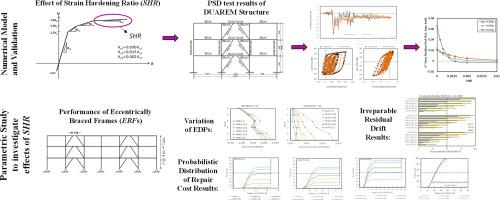Journal of Constructional Steel Research ( IF 4.0 ) Pub Date : 2021-09-16 , DOI: 10.1016/j.jcsr.2021.106948 Elif Müge Ün 1 , Cem Topkaya 1

|
Performance based seismic design (PBSD) procedures have been developed in recent years. Studies conducted in the past revealed that strain hardening ratio (SHR) used in numerical modeling can be influential on the performance of steel structural systems. In this paper, the effects of SHR on the performance assessment of eccentrically braced frame (EBF) buildings were studied by using FEMA P-58 methodology. The numerical model was validated using the pseudo-dynamic test results of the DUAREM structure. Seismic performance of six archetype EBFs with different number of stories and link length to bay width (e/L) ratios were evaluated under design basis earthquake (DBE), maximum considered earthquake (MCE), and collapse level earthquake (CLE). Irreparable residual drift, repair cost and unsafe placards were calculated for SHR ranging between 0 and 0.01. The results showed that the residual interstory drift ratio is more influenced by the SHR when compared with the interstory drift ratio, link rotation angle and story acceleration. The replacement decision was found to depend on the SHR, the number of stories, the e/L ratio, and the seismic hazard. Under MCE and CLE level events, almost all of the archetypes with SHR ≤ 0.003 required replacement while replacement can be avoided for some of the archetypes with SHR > 0.003. Under DBE level events, 3-story archetypes and 6-story archetypes with SHR ≥ 0.002 did not require replacement. Nine-story archetype with e/L = 0.08 required replacement for SHR = 0 only, while archetypes with e/L = 0.12 required replacement for SHR ≤ 0.003. The study demonstrated the strong influence and sensitivity of the repair cost to the SHR.
中文翻译:

循环应变硬化对偏心支撑框架性能的影响
近年来,已经开发了基于性能的抗震设计 (PBSD) 程序。过去进行的研究表明,数值建模中使用的应变硬化比 ( SHR ) 会影响钢结构系统的性能。在本文中,使用 FEMA P-58 方法研究了SHR对偏心支撑框架 (EBF) 建筑物性能评估的影响。使用DUAREM结构的伪动力测试结果验证了数值模型。具有不同层数和连接长度与间隔宽度 ( e / L )的六种原型 EBF 的抗震性能) 比率在设计基准地震 (DBE)、最大考虑地震 (MCE) 和倒塌级地震 (CLE) 下进行评估。不可修复的残余漂移、维修成本和不安全标牌的计算SHR范围在 0 到 0.01 之间。结果表明,与层间漂移率、连杆旋转角度和楼层加速度相比,残余层间漂移率受SHR的影响更大。发现更换决定取决于SHR、楼层数、e / L比和地震危险。在 MCE 和 CLE 级别的事件下,几乎所有带有SHR的原型 ≤ 0.003 需要更换,而对于SHR > 0.003 的一些原型可以避免更换。在 DBE 级别的事件下,SHR ≥ 0.002 的 3 层原型和 6 层原型不需要替换。e / L = 0.08的九层原型 仅需要替换SHR = 0,而e / L = 0.12 的原型需要替换SHR ≤ 0.003。研究表明,维修费用对SHR有很强的影响和敏感性。











































 京公网安备 11010802027423号
京公网安备 11010802027423号